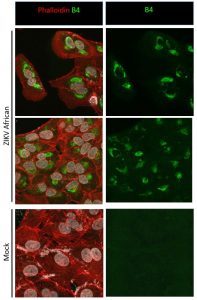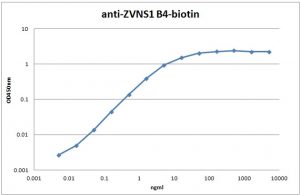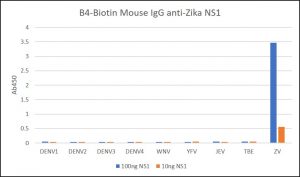
Image by Virology Research Services Ltd
Immunofluorescence: Vero cells were seeded on coverslips infected with ZIKV (African or Asian strains) for 30h at MOI 0.5. Control coverslips consisted of uninfected Vero cells. After fixation with 4% PFA, samples were stained with unconjugated Mouse Anti-Zika Virus NS1 Antibody (AbZIKVNS1-B4). Antibody was diluted 1:500 and Triton X-100 was used as detergent. Imaging was performed using a Leica SP5 confocal microscope (Virology Research Services).

ELISA assay: An ELISA plate was coated overnight with ZVNS1 100ng per well in D-PBS (Gibco 14190-136) and the following day blocked with 1% BSA (Sigma A7906) in PBS. Biotinylated antibody was diluted in 0.5 log steps from 5000ng/ml to 0.005ng/ml in PBS/BSA/0.05% Tween 20 and incubated in the wells, static, for 1 hour. After washing, the plate was incubated with Streptavidin poly-HRP (Thermo #21140) diluted 1 in 40,000 in PBS/BSA/Tween, static, for 30min. After washing, TMB (KPL Sureblue) was added and the plate developed 15min, stopped with 1M HCl before reading at 450nm. Blanked OD450nm was plotted against antibody concentration ng/ml. An ABT50 of 8.0ng/ml was calculated from the direct antibody ELISA.

ELISA assay: An ELISA plate was coated with 10ng and 100ng of NS1 antigen per well, then blocked with 1% BSA. Primary antibody was used at a concentration of 1ug/ml, and the detection antibody used was Goat anti-mouse IgG:HRP (Bio-Rad, 1:2000). The substrate used was TMB (KPL). The assay confirmed high specificity for Zika virus NS1; there was no cross-reactivity with NS1 from Dengue virus serotypes 1-4 (DENV), West Nile virus (WNV), Yellow Fever virus (YFV), Japanese Encephalitis virus (JEV) and Tick-borne Encephalitis virus (TBE).
MOUSE ANTI-ZIKA VIRUS NS1 ANTIBODY (B4):BIOTIN CONJUGATE
Mouse anti Zika virus NS1 antibody is specific for the NS1 protein of Zika virus, detecting NS1 from both the Uganda and Suriname strains. It demonstrates negligible cross-reactivity with NS1 proteins from Dengue virus (all serotypes), Japanese Encephalitis Virus and Yellow Fever Virus. This mouse anti Zika virus NS1 antibody has been optimally conjugated to biotin, and is suitable for use in direct ELISA and in sandwich ELISA. Due to the hexameric nature of the NS1 antigen the B4 antibody will “pair” with itself in a sandwich assay. It may also be used as a “pair” with clone D11. This antibody has not been tested directly for use in immunofluorescence assays, but AbZIKVNS1-B4 (unconjugated Mouse Anti-Zika Virus NS1 Antibody) has been validated for immunofluorescence. Therefore, it is likely that conjugated antibody would perform in a similar manner.
PRODUCT DETAILS – MOUSE ANTI-ZIKA VIRUS NS1 ANTIBODY (B4):BIOTIN CONJUGATE
- Mouse anti-Zika virus NS1 protein monoclonal IgG1 antibody (clone B4) conjugated to biotin.
- Greater than 95% purity by SDS-PAGE and buffered in PBS, pH7.4.
BACKGROUND
The NS1 protein is a major non-structural protein expressed by the Zika Virus. The NS1 monomer is a glycosylated protein of approximately 45kDa, which associates with lipids and forms a homodimer inside infected cells. It is necessary for viral replication, and is also secreted into the extracellular space as a hexameric lipoprotein particle, which is involved in immune evasion and pathogenesis by interacting with components from both the innate and adaptive immune systems, as well as other host factors. NS1 is one of the major antigenic markers for viral infection with Zika.
Zika virus is an emerging disease that is spread by Aedes mosquitoes. The virus was first isolated in Central Africa, and has since spread to South Asia and more recently to South America. It is a member of the flavivirus family, and is structurally closely related to viruses such as Dengue Fever Virus. Outbreaks were reported in Micronesia in 2007 and in Brazil in 2015, confirming at least 13 autochthonous infections. The Zika virus outbreak in Brazil in 2016 has gained world-wide attention, and has been linked to an increasing number of microcephaly cases. In April 2016 the Centers for Disease Control, in the USA, confirmed the link between Zika virus infection of the fetus with microcephaly.
Clinically Zika virus can cause mild fever, rash, myalgia, arthralgia and headaches, with one in four infected individuals being asymptomatic. Due to similar symptoms Zika virus infected individuals can easily be mis-diagnosed as a dengue infection and vice-versa. In addition, Zika virus has been implicated in causing microcephaly through transmission in utero. There is no vaccine or specific treatment available for Zika virus.




